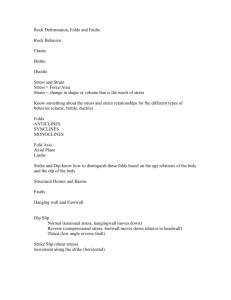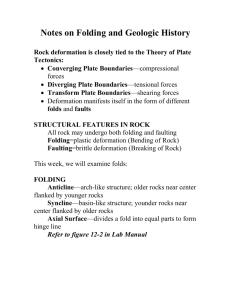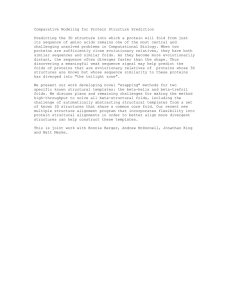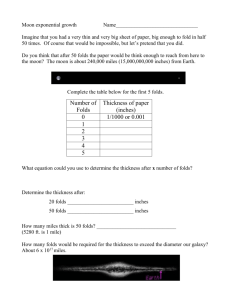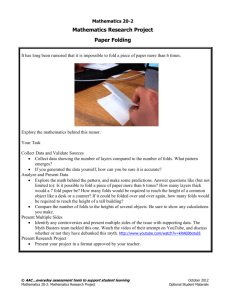GY 111: Physical Geology Lecture 22: Folds UNIVERSITY OF SOUTH ALABAMA
advertisement
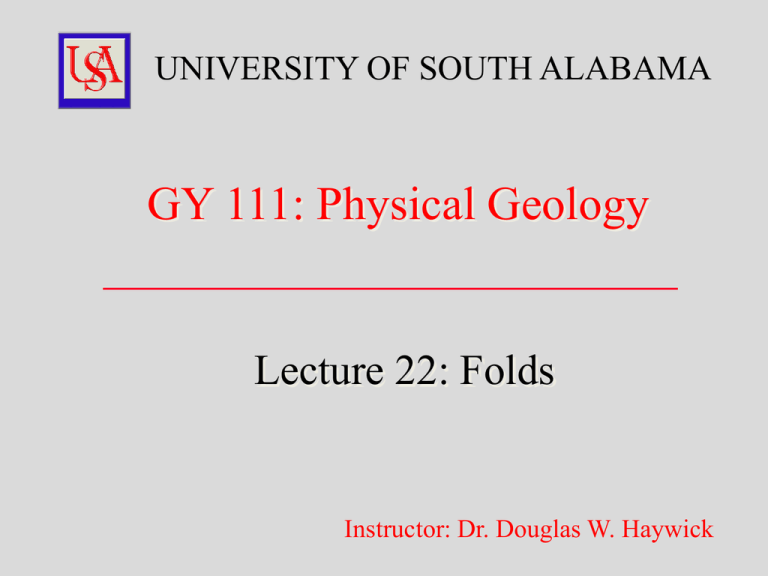
UNIVERSITY OF SOUTH ALABAMA GY 111: Physical Geology Lecture 22: Folds Instructor: Dr. Douglas W. Haywick Last time (before the exam) Rock Deformation A) Confining pressure and rock deformation B) Elastic versus permanent deformation C) Types of deformation Web notes 20 Lab Manual Chapter 5 Rock Deformation Rock deformation: any change in the volume, shape or orientation of a rock body. Rock Deformation The strength of materials (including rocks) can be tested in labs using hydraulic presses. All materials behave elastically up to a point. Once past the elastic limit, deformation becomes permanent. Stress & Strain Stress: a force applied to an area (Example: tire pressure in psi) Strain: the amount of deformation produced by stress Elastic strain: analogous to a steel spring or rubber band Plastic strain: analogous to deforming mud or putty Brittle strain: analogous to breaking glass Stress vs. Strain Diagrams • Illustrate the mechanical behavior of rock materials • Ductile deformation requires a significant component of plastic mechanical behavior Ductile Deformation plastic Elastic Limit Stress Distortion below the elastic limit is 100% recoverable Strain % Stress vs. Strain Diagrams • Illustrate the mechanical behavior of rock materials • Brittle: rocks near the surface of the Earth behave as brittle materials Brittle Deformation Rupture Stress Distortion below the elastic limit is 100% recoverable Strain % Mechanical Behavior of Rocks Near-surface rocks that are under low T-P conditions behave as brittle material: – Fault fracture (slippage) – Joint fracture (no slippage) Deep rocks under elevated T-P conditions behave as ductile material: – Folding Today’s Agenda A) Types of folds B) Anatomy of a fold (terminology) Last Call for Mac and Cheese Bonus Web notes 22 Lab Manual Chapter 6 Folds http://www.geosci.unc.edu/faculty/glazner/Images/Structure/Folds.html Folds http://www.parstimes.com/spaceimages/zagros_anticlines.jpg Folds http://www.geology.wisc.edu/~maher/air/130-27v.jpg Folds Anticlines: Open downwards Synclines: Open upwards Folds Folds Please note: Folds are 3-dimensional structures Folds Folds are simply bent planes and as such, can be described using strike and dip connotation Folds Fold axes on maps are indicated with the following symbols: Folds are simply bent planes and as such, can Anticline be described using strike and dip connotation Syncline Folds A simple geological map of an anticline Folds At the point(s) of maximum curvature, the dip of the fold is 0º Folds Folds can be horizontal or plunging Plunging Folds Asymmetrical Folds Folds on Maps Some of you will interpret these in an upcoming lab exercise Anticline Oblique View Geological Map (no scale implied) Folds on Maps Some of you will interpret these in an upcoming lab exercise Syncline Oblique View Geological Map (no scale implied) Folds on Maps As well as more complex structures Today’s Homework 1. Study! Why wait for the day before the final? 2. Assignment 4 next Thursday 3. Thursday lab students: sed rock exam 4. Go up to a total stranger and give them a hug (then run away very fast) Next Time Faults GY 111: Physical Geology Lecture 22: Folds Instructor: Dr. Doug Haywick dhaywick@southalabama.edu This is a free open access lecture, but not for commercial purposes. For personal use only.
